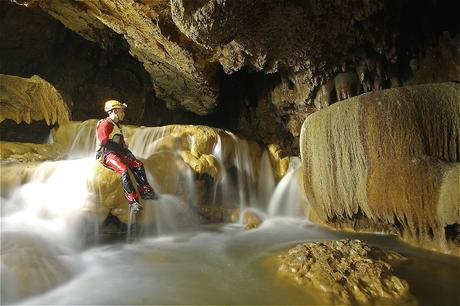
There’s an alien world right under our feet. It’s a world where nothing is what it seems, where wonders defy imagination, and where the most trivial decisions can determine whether we live or perish. The world of mysterious caves is a part of our beloved blue planet. Yet we know more about the twinkling stars above us than the geological, meteorological, and biological marvels beneath the ground. That is not a surprise for these dark caves are delicate yet hostile environments. Visiting these dark realms require thorough preparation, careful training, and utmost respect.
Thus, we considered ourselves very privileged when Sir Joni Bonifacio, a professional cave master and owner of the prestigious Catbalogan-based adventure outfitter Trexplore, invited us to join him on a 4-day caving adventure in his place. We agreed without any hesitation. After all, we don’t want to miss the opportunity to explore the caverns of Samar, the country’s caving capital. Our first destination, as planned by Sir Joni, is Lobo Cave, touted as one of the most beautiful caves in the Philippines.
We took a rainy evening flight from Cebu to Tacloban, followed by a 2-hour bus ride to Catbalogan, the capital city of Samar. Tired and weary from an entire night’s travel, we finally arrived in Catbalogan at 12:30 AM. As we disembarked from the bus, we heard a friendly voice calling our name. It was Sir Joni, his face beaming with a hug, welcoming smile. We introduced each other before he led the way to his warm home, which is just a block away from the bus stop.
We were simply overwhelmed by their hospitality. Sir Joni prepared a nice, clean, air-conditioned guest room for us where we could spend the night. After a sound sleep, we woke up and enjoyed a hot breakfast prepared by his wife. We then met our team—Edgar of the award-winning travel blog EAZY Traveler and hardworking OFW adventurer Luis.

By 8 AM, we were ready to depart to Lobo Cave. We took a short jeepney ride and an equally short habal-habal ride to our jump-off point in Barangay Tagbaya-on high up in the hills of the municipality of Jiabong.
We were very impressed to see how Sir Joni ensured excellent and smooth coordination. There were absolutely no hiccups or hassles. In fact, at the jump-off, Sir Joni’s co-guides and porters were already there, hauling our caving equipment. There was no waste of time or effort.

We started a 40-minute trek along the ridge of a hill that is dotted with familiar farmlands and coconut groves. Good thing the morning was overcast otherwise it would have been a really scorching hike. Along the way, we enjoyed scenic vistas of the azure Maqueda Bay and the neighboring mountains of Calbiga.
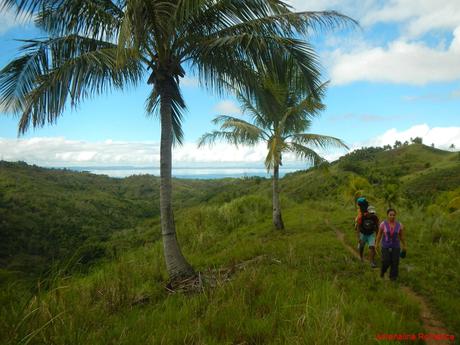
Be careful! We needed to descend down a steep hill that has been plowed to make way for a farm. As a result, the fertile soil was loose and a little bit muddy.

After walking along a dry but very slippery riverbed, we finally reached the entrance of Lobo Cave, which looks deceptively ordinary. Furthermore, a person can only see the cave at the riverbed’s level; no one can see it from above. In other words, the cave is located at the bottom of a mountain valley thus its namesake; the word Lobo means “depression” in the local dialect.
We learned from Sir Joni that although locals frequent the area surrounding Lobo Cave, they rarely go inside the cave itself out of fear. They believe there are enkantos, or fairies, inside these unknown caverns who are ready to lure unlucky trespassers to their dark realm, never to see the light of day again.
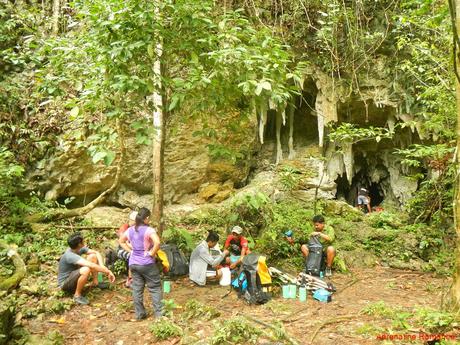
While the porters prepared our equipment, Sir Joni conducted a thorough briefing which included a brief history of caving, the protocols of responsible caving, our itinerary for the day, and the attractions inside Lobo Cave. As you can probably see, we were all ears.
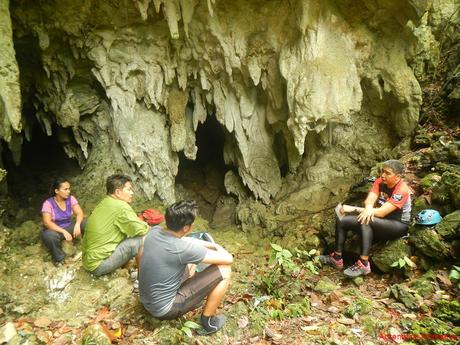
All set? Yes, we were definitely ready! One thing you might find interesting in the photo below is that we were wearing overalls. Sir Joni said this is necessary because we’re going inside wet and muddy places.
We also donned helmets to protect our heads from falling rocks. Everyone was equipped with powerful Petzl headlamps as well so we can see in the dark. Gloves were worn to protect our hands from sharp rocks as well as to protect fragile cave formations from the oils of our hands. Finally, Sir Joni required us to wear proper trekking shoes rather than open trekking sandals to prevent cuts, bruises, and punctures on our feet.
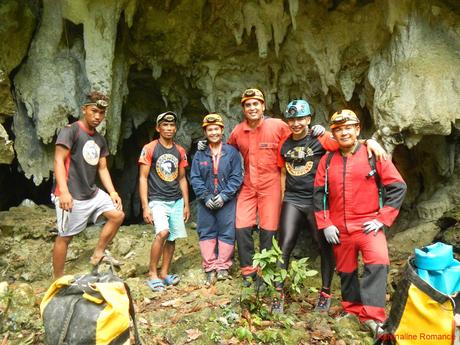
As soon as the daylight disappeared and pitch-black darkness began to engulf us, the beauty of the cave began to unravel. Our headlights shone on innumerable strange rock formations.
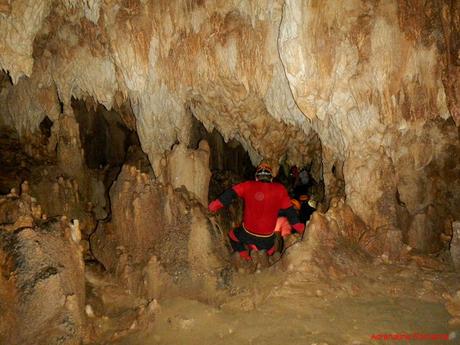
These short, blunt, penile stalagmites look similar to the ones we saw in Bolitas Cave in Sohoton Bay. Because people rarely came here, virtually every rock formation in Lobo Cave is in pristine condition.
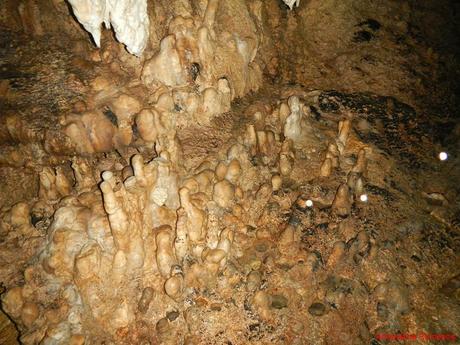
After a little while, we reached the Main Chamber, named so because it is the largest chamber in the cave. It is so large that the our Petzl headlamps, powerful as the are, could barely reach the ceiling. High above us, bats and swifts chirped happily, singing their cantata to welcome the mere flightless mortals below them.
The Main Chamber acts like a hub, with various alleys leading away from it like spokes of a wheel.

Sir Joni led us to a winding, narrow passage where we walked, crawled, and slid into the darkness, guided only by the light of the person in front of us. Aside from carefully watching where we step, we had to be equally careful on our handholds. We don’t want to inadvertently damage delicate rock formations.
Why are we being so careful? you might ask. Well, you have to understand that caving is a high-impact activity. That means, the presence of a person or a small group can considerably alter a cave system. We are doing our best to minimize the effect of our visit to this dark realm.
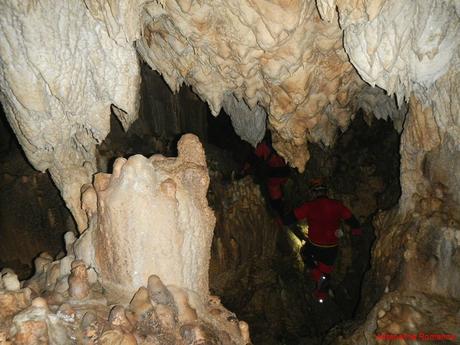
At the end of this passageway is a room that houses one of the most beautiful rock formations we’ve ever seen. Sir Joni calls this The Angel Wings, and it’s easy to see why it is called so. The large stalagmite, which resembles a torso, joins the expansive flowstone on the ceiling. Overall, they form a figure that resembles a mythological angel.
Thanks to the calcite crystals embedded in the ceiling, walls, and rock formations in the room, the whole place glitters wherever our light touches. It was as if there were thousands upon thousands of twinkling stars around us. The angel figure, the silence, and the sparkling room all add up to an otherworldly, ethereal atmosphere.

(Photo credit: Edgar Alan Zeta Yap)
After taking a few shots, we returned to the main chamber so we can access another passage. Along the way, we found this massive terrace-like cave formation. This is called a rimstone dam, and could extend over a hundred feet or so.
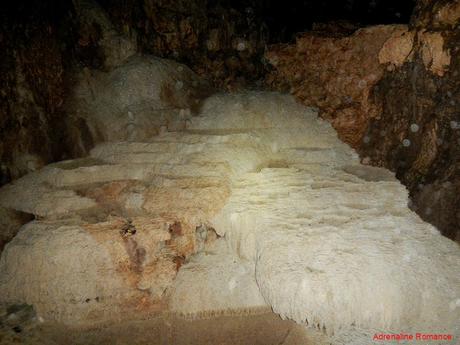
Look at those glittering speleothems, or cave formations. Speleothems are secondary mineral deposits that are formed of acidic water and calcium carbonate. Over many years, the calcium carbonate builds up on the cave wall, creating these amazing formations.
The speleothem glitters due to the presence of thousands of gypsum crystals embedded in it. Wow!
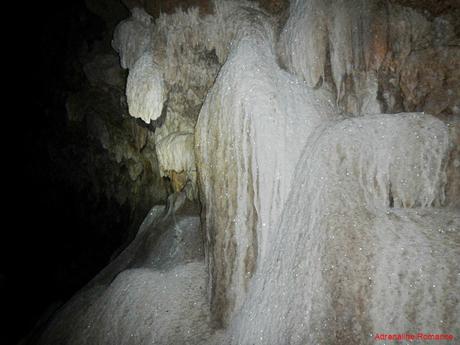
The passage suddenly widened into what Sir Joni calls the Grand Canyon. Yes, we have an underground Grand Canyon in Samar! We walked at the bottom of this narrow but enormously tall gorge. The Grand Canyon is so tall that we our lights couldn’t reach the ceiling!
The ground is made up of dark, very loose, very fine sand. Walking on it felt labored and weird.

(Photo credit: Edgar Alan Zeta Yap)
Somewhere along this 200-meter-long Grand Canyon, we found this nice natural tub of water; the rock bed has eroded to form a depression, and rainwater filled it up. The water was so refreshingly cool that we took a dip—shoes and all!

(Photo credit: Edgar Alan Zeta Yap)
With our sweat washed off, it was time to move again. A bit farther from the Bathtub, the walls became wetter, and the air become laden with moisture. We began to hear the pitter-patter sound of water dripping from stalactites way above us and at the sides of the Grand Canyon’s wall.
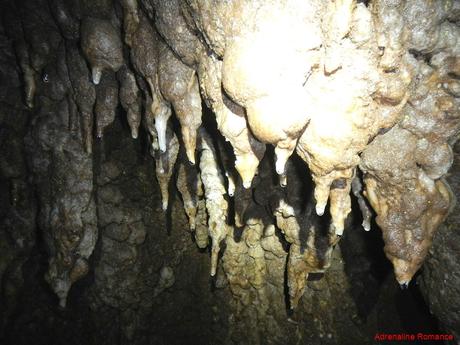
Nearing the end of the Grand Canyon, we could here the faint but unmistakable sound of powerful, rushing water. But where could it be? There was no flowing stream or river along our way.
Well, it turned out that there is indeed an underground river right beneath us. Yes, believe it or not, it’s deep inside the “basement” of Lobo Cave. The cave was much deeper than we initially thought.
But to reach that river, we had to climb 10 feet down this tiny, slippery hole. The Diamond Hole passageway is so small that only one person could fit at a time. A sturdy anchor and a safety line were rigged to allow us to go safely down this rabbit hole.
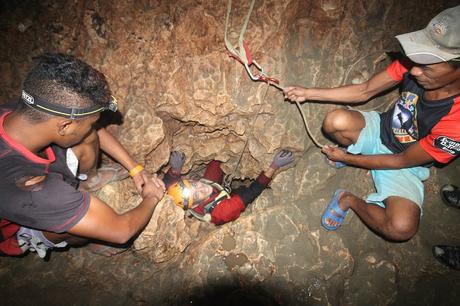
(Photo credit: Edgar Alan Zeta Yap)
Once everyone made it down the Diamond Hole, we donned our PFDs and proceeded to the source of the rushing sound. And then, there it was, a powerful cascading waterfall surrounded by amazing rock formations inside the depths of the earth. That fact was so stunning that it was surreal.

(Photo credit: Edgar Alan Zeta Yap)
After Edgar took his much-needed shots, we went upstream to explore the river. In many places, the water was quite deep, necessitating the need of a PFD for safety. While swimming, we had to be careful with our strokes because there were sharp rocks that are fully submerged.
That means, diving inside the cave is absolutely prohibited.
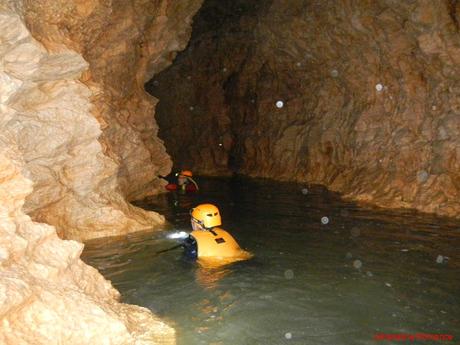
At times, the water became shallow enough so that we can actually wade through. Still, we had to be careful where we step because there were deep holes concealed by the dark water.
Those sharp rock formations at the side of the tunnel are called speleogens. Rather than mineral deposits, they are actually chunks of bedrock removed by water, earthquakes, and other erosive forces.
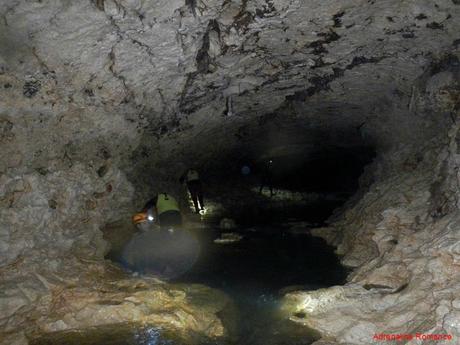
Doesn’t this adventure remind you of something? No? What about canyoning? Aha! Yes, it’s similar to canyoning without the jumps and rappels. Just think about it: it’s canyoning several hundred meters under the earth’s crust! Now that’s really something, isn’t it?
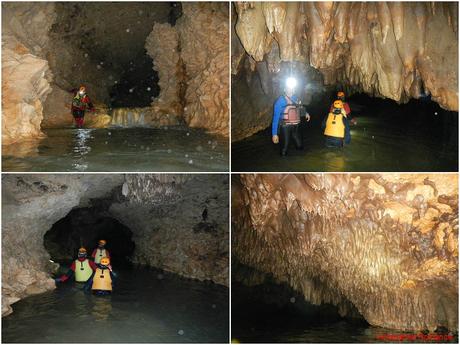
Finally, after an hour, we reached the end of the cave; we could no longer go farther unless we have scuba gear and special training in underwater cave diving. The water’s flow comes from a small hole that can barely fit a human being.
After swimming around in a relatively deep pool, we headed back downstream.
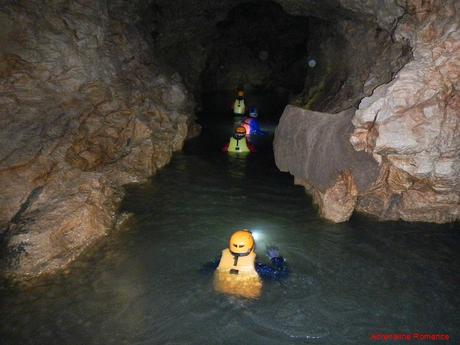
But our underground river adventure wasn’t finished! Midway during our return swim, we went ashore towards that big dark hole behind Sweetie and Luis. What could be behind that ominous, lightless hole?
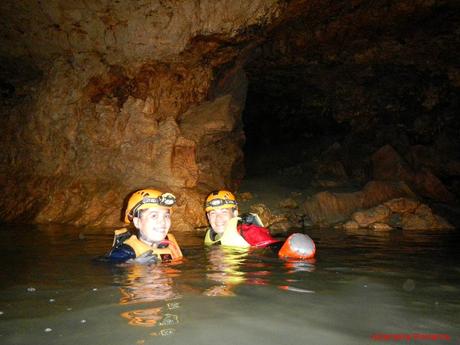
Sir Joni told us we have reached the Mud Chamber. Moisture from the underground water and water trickling down the stalactites in the cavern soaks the soft soil on the cave floor. As such, the ground is super wet, sticky, and muddy. It’s obviously not a place for those who want to be immaculately clean.
But there’s pure fun in the dirt as you can see in the photo below. Look at our beaming faces.
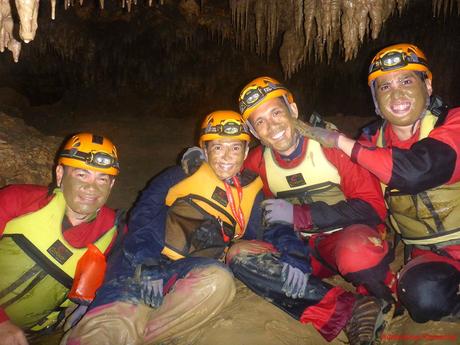
(Photo Credit: Joni Abesamis Bonifacio)
We laughed heartily as we smeared our hands and faces with cave mud. We rolled and got ourselves dirty. Haha! We were like children again playing in the mud.
Sir Joni explained that the mud has healing properties. Well, let’s see if this cave-borne poultice can take away our whiteheads, blackheads, and blemishes.

But no matter how much fun we had crawling and rolling around, we had to be extremely careful not to break the sharp stalactites right above us. We couldn’t stand up as our helmets will hit those delicate formations, some of which are as thin as drinking straws.
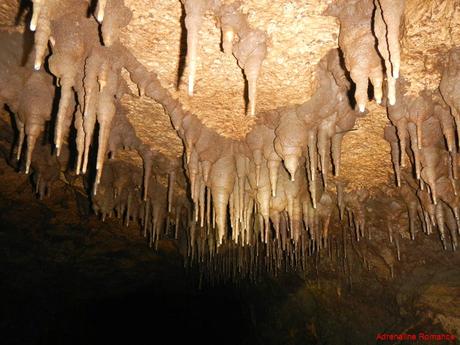
After a while, we left the Mud Chamber and re-entered the river. The clear, chilly water washed off the traces of mud as we slowly swam with the current or waded on the shallow edges. Just check out how big this river tunnel is.
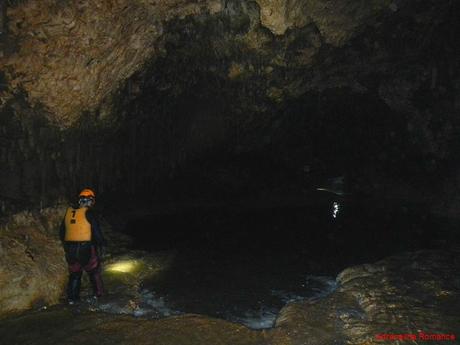
But in some areas, the tunnel’s ceiling is just a foot or two above our heads. We do hope you’re not claustrophobic if you choose to undertake this extreme adventure.

On the way back, Sir Joni led us to a dark section beside the waterfall so we could check out this large, wig-like flowstone. Like a stalactite, a flowstone is a secondary mineral formation that is created by accumulated calcium carbonate.
The presence of white dots in the photo is not a sign of camera malfunction. This is actually the mist that the waterfall creates.
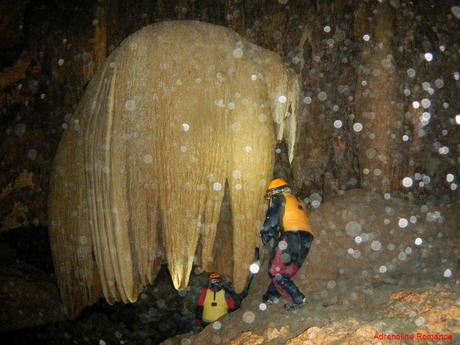
After letting the waterfall gently massage our backs for a few minutes, we headed back to the Diamond Hole. Climbing it was slightly trickier as the heavy mist has made the rockbed slicker than usual. We had to be careful in climbing through the hole even though we were safely fastened to the anchor.
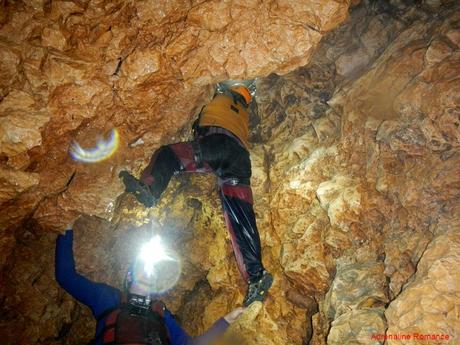
After everyone got out, we headed back to the Main Chamber where our porters prepared a simple but delicious lunch of pork adobo and stir-fried mixed vegetables for everyone. Just right on time as it was already almost 1 PM, which was past our normal lunch time. No wonder our stomachs were grumbling loudly!

With lunch out of the way, it was time to explore the upper parts of the cave; yes, there’s a second level! Along the way, we encountered rock formations that we’ve never seen in our entire adventuring lives. There were stalagmites that look like miniature versions of the towers of the unfinished Sagrada Familia in Barcelona. There was an interesting one—the fourth photo—that looks exactly like a fat longaniza (Philippine sausage).
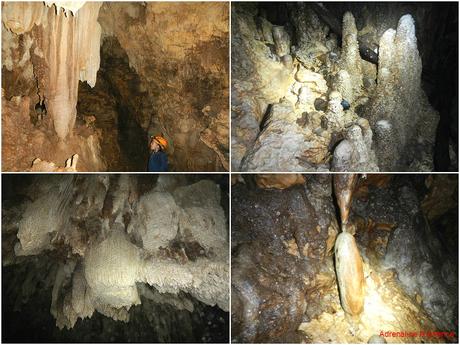
Having a full meal made us feel bloated and heavy, and that didn’t help at all in climbing this cliff. Yes, we said cliff—–a cliff, concealed in darkness, inside a cave. We’ll show you a better view of the cliff a bit later on our return back to the Main Chamber.
We rigged up a line that acts as a handrail to help us ascend safely.
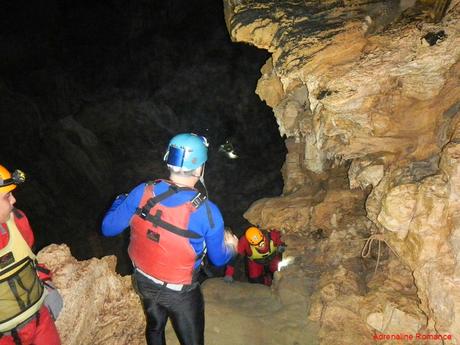
Upon reaching the top of the cliff, our jaws dropped. It was another huge chamber that rivals that of the Main Chamber. Sir Joni christened this as the Dream Chamber because it is so full of unearthly wonders that the scenery feels unreal. You will know what we’re talking about in the next set of photos. Yes, we went deep inside there!
Can you imagine how many millions of years Mother Nature carved this alien wonder? Can you imagine how man, in his greed and indifference, can destroy this masterpiece in just a few days?
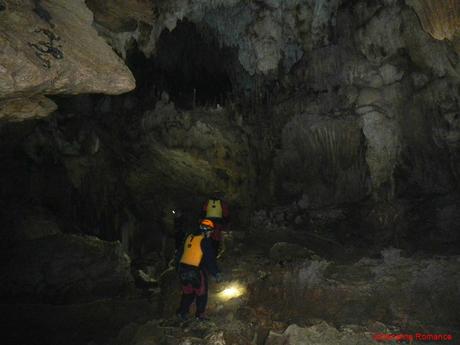
In this level, there were many new things to see. For instance, check out these beautiful, curvy cave pools, carved by water hundreds or thousands of years ago. They are similar but more shallow than the Bathtub in the Grand Canyon. Sir Joni said that during very heavy, sustained rains or cloudbursts, these pools sometimes get filled up.
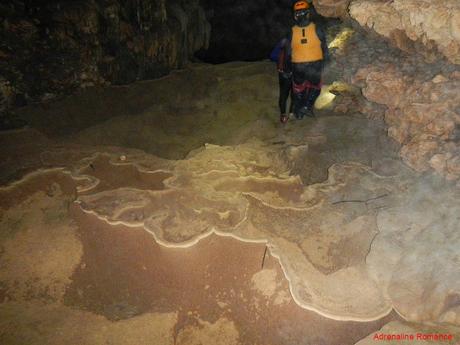
We also saw these bowl-like rocks along the cave floor. At first glance, they look man-made. But no, they are completely natural, painstakingly made by Mother Nature. Each one of these rock formations is as large as a human head.
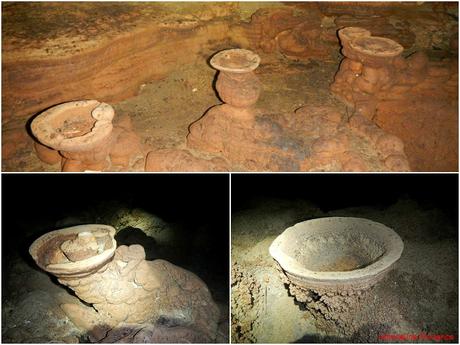
Another highlight of this level is this huge flowstone that acts like an umbrella to protect us from disgusting bat and swift poo that unexpectedly drops from above.
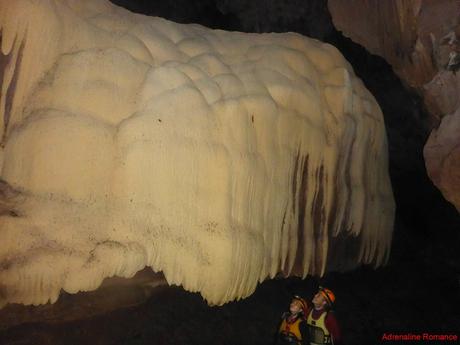
(Photo credit: Joni Abesamis Bonifacio)
At first, we thought that this delicate white net-like substance is part of a tree’s root system. But no root system can penetrate this deep in the earth. Could it be a huge web of some sort? As we pondered what it is, Sir Joni explained that it is some sort of albino cave mold.
That is just amazing! There are so many things about caves that we never knew about. Discovering the wonders of Lobo Cave is like having a practical geology class with lots of actual adventure.
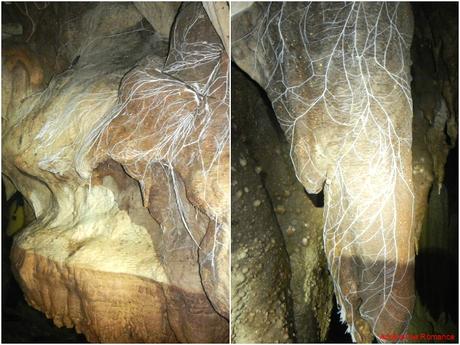
Soon, we came to another dark underground river. Although the strength of the current was imperceptible, the water here is even colder than the one at the cave’s basement.
This river has several interesting features. Check out the photo below. One, you can actually see the “high tide” line, which means that in certain conditions, the water can rise up that high. Two, check out the side of the banks. Notice the crumbly formations that stick to the wall? Those are young shelfstones, another kind of speleothem. Due to the frequent changes of the water’s level here, these shelfstones didn’t have time to fully harden. Thus, they are very delicate and can crumble with the slightest touch.
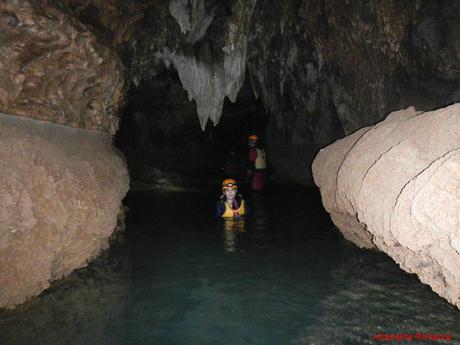
Caves have their own unique ecosystem, and thus, they’re populated by unique organisms that have adapted to absolute darkness. A perfect example of such organism is this white blind cave crab. Its eyes are completely useless in the dark, thus it is completely blind, relying on its sense of touch to navigate and hunt. Also, the complete lack of light causes its albinism.
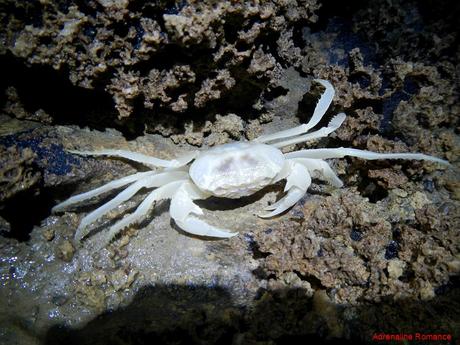
These cave crickets hurriedly scurry out of our way. To compensate for their lack of wings, these insects have large and powerful legs which allow them to jump enormous heights. Their most distinguishing feature, however, is a pair of very long antennas, which they use to feel their surroundings. Each of the antennas are more than twice as long as the cricket’s body!
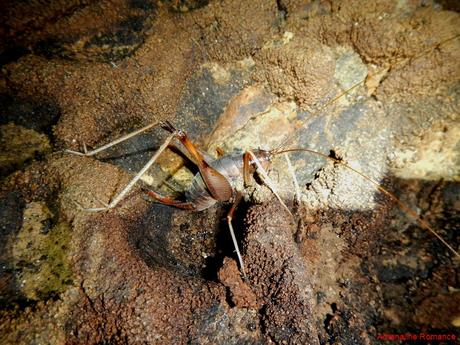
Of course, everyone is familiar with the stereotypical denizens of the caves—furry bats! The only mammals capable of winged flight, bats find their way around the cave using a sophisticated biological sonar-like navigation system called echolocation.
A bat emits pulses of high-frequency sound that we, humans, cannot hear. When the pulses hit an object, they echo back to the animal. Using this “information,” a bat can fly and hunt in total darkness.
Bats here do not give a damn about humans visiting their realm. In fact, we didn’t have any problem in taking a photo of this little guy. He just hanged upside down right at eye level on the wall. Our cameras were so close, but he didn’t move an inch. He probably has a career as a model. Hehehe!
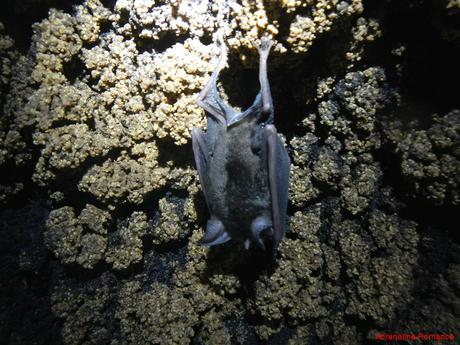
After an hour or so of trekking, scrambling, and swimming, we climbed up a slippery slope and arrived at the Dream Chamber’s dead end. This place is called the King’s Chamber, and it’s easy to understand why. Those thin, delicate candlestick stalagmites resemble people facing a pure white flowstone “throne” way back at the wall of the room.
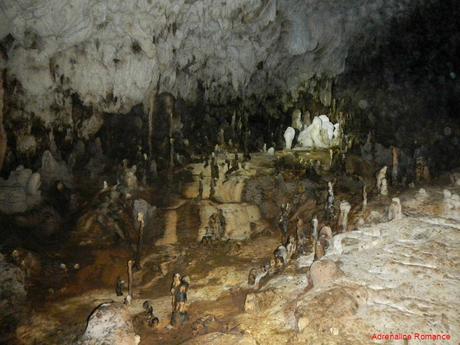
We also found this unusual rock formation resembling a big, slanted, round table with small stalagmites growing on it. For a moment, they look like table corals that we usually find underwater when we go scuba diving.
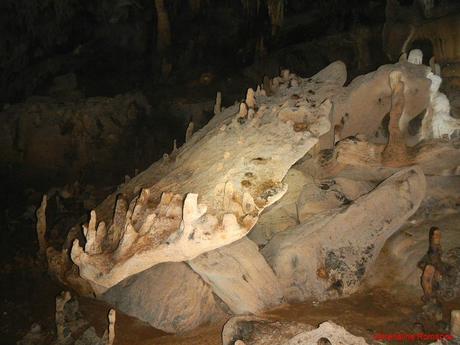
Like a massive centurion, this huge flowstone guards the entrance to the King’s Chamber. Can you imagine how many eons did it take for this glittering flowstone to form?
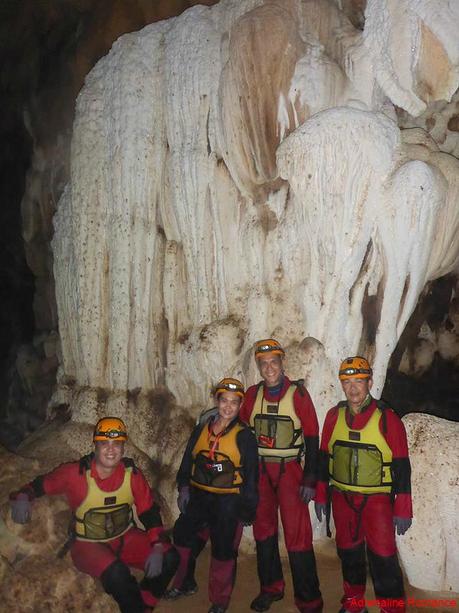
(Photo credit: Joni Abesamis Bonifacio)
Upon checking our watches, it was approaching 3 PM. It was time to go back, leave the King’s Chamber, and, ultimately, step outside Lobo Cave.
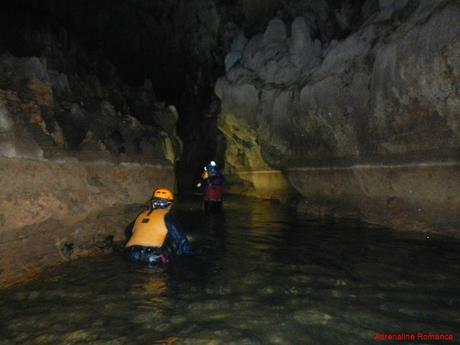
On the way back, we chanced upon these hair-like things hanging from the cave wall. We thought they were very thin, very fragile stalagmites. But no. Believe it or not, these are a species of glowworms, and they are very much alive. They capture and feed on small insects that are ensnared in their hairs.
As their name implies, these organisms actually glow to attract prey. However, they are extremely sensitive to light; they stop glowing when disturbed or when they are illuminated.
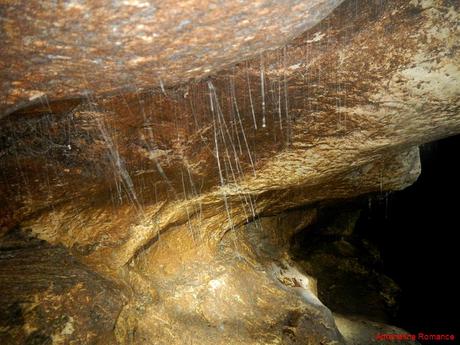
These giant chandeliers are truly amazing works of natural art that took millenia to form. The underside of these chandeliers are very delicate and should not be touched.
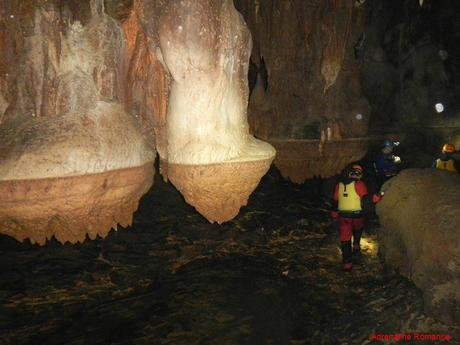
The last hurdle in reaching the main chamber was also the first. Remember that we said that we’re going to show you a cliff inside the cave? Well, this is it! We clung to our dear lives as we carefully tread on the edge, using razor-thin ledges for footholds. The rope is placed there as a safety hand rail. Can you imagine if you take an unfortunate mis-step to the right?

For almost half an hour, we followed another underground river that leads to Sir Joni’s traditional exit, a small opening that leads to a natural pond outside the cave. Unfortunately, upon reaching the end of the conduit, the exit tunnel was nowhere to be seen. Apparently, it was raining outside while we were inside Lobo Cave, and the opening was underwater. We could dive under and swim a short distance, but that would be very risky.
With no other choice, we went back to the Main Chamber and backtracked to the entrance. We were a wee bit disappointed for not exiting the pond, but such are the vagaries of adventuring. Safety first, fun later.
By the way, check out the bats flying right above us. Some probably have problems with their echolocation as some collided with our helmets. Hahaha!
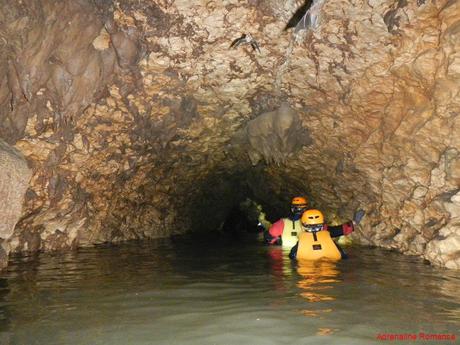
Finally, after close to 7 hours inside Lobo Cave, we finally saw the bright glow of a fine afternoon. True, we were mesmerized by the beauty of this underground realm. However, nothing feels better than being back in your own world.
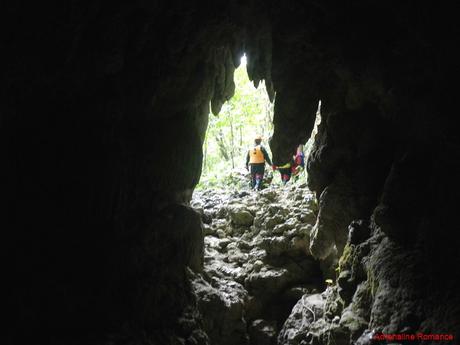
A Silent Canoeing Adventure
Being out of Lobo cave wasn’t the end of an awesome adventure; it was the start of a new one although not as adrenaline-pumping as our 7-hour caving sojourn. We took off our caving gear, which were then hauled by our porters. After a short rest, we followed a slippery, plant-covered tributary that led to Panaghoyan River.
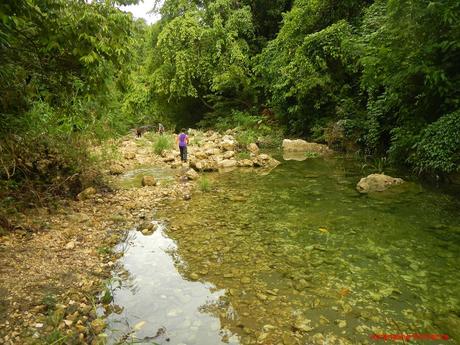
At the foot of the river, we were surprised to see wooden dugout canoes waiting for us. These simple but ingenious vessels were laboriously carved from whole logs. Holes and cracks were filled up with modern sealant and traditional tar. Without outriggers to stabilize the boat, the canoes rocked at the slightest move.
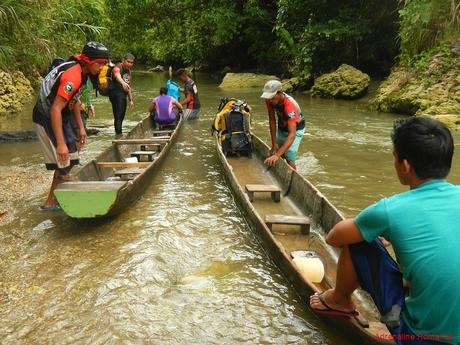
All set? Then off we went. Check out the coffee-colored water. That’s an indication of heavy rainfall.
Panaghoyan River is quite shallow. Several times, we had to disembark from the canoe because our combined weight causes the boat to run aground the soft, sandy riverbed.

“This feels as if we are on an expedition in the Amazon,” Ed remarked, his awe unmistakable in his voice.
We paddled slowly along the calm river, which was surrounded on both sides by thick forests, green mangroves, and moss-covered cliffs. The voyage was so serene, and the silence was broken only by the sound of oar gently splashing on the water with each stroke. It is during these very quiet and peaceful moments that one can truly commune with Mother Nature.
Panaghoyan River, by the way, is called so because locals traversing the waterway enjoy listening to sweet bird whistles. “Taghoy” is the Visayan term for whistle.
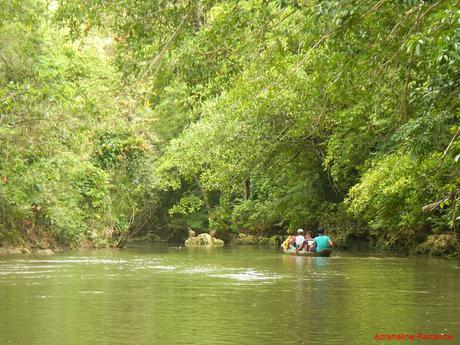
Almost an hour later, we reached the head of the river at the town of Jiabong where we waited to catch a bus back to Catbalogan City. This humble town is known over the Samar province as a top producer of quality mussels.
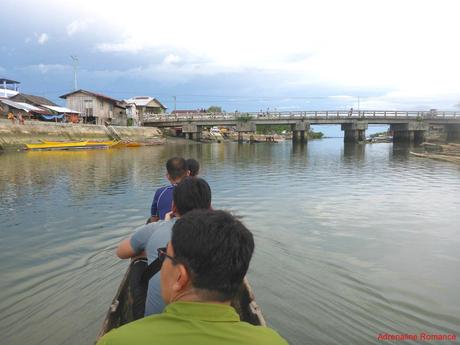
(Photo credit: Joni Abesamis Bonifacio)
No extreme adventure is complete without an extreme ride. This is called commonly called top-loading, and it involves riding on the roof of a fast-moving jeepney. Obviously, this is dangerous, and top-loaders struggle against the wind, dust, flying insects, and overhanging branches. However, it’s really fun, and you get to see the best 360-degree views.
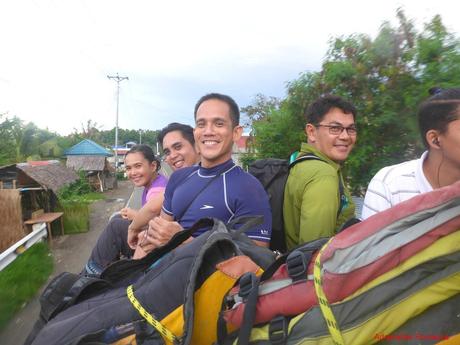
(Photo credit: Joni Abesamis Bonifacio)
There’s an alien world right under our feet, and what a place it was! Exploring the magnificent Lobo Cave was one of the most extreme and enjoyable adventures we ever had. Who knew that exploring caves could be so much fun, exciting, and adrenaline-pumping? Who knew that this adventure would give us a glimpse of Mother Nature’s most intricate wonders and delicate artworks? Who knew going inside the caverns of Lobo Cave would show us an ever-changing world about that is concealed from human eyes?
Visit Lobo Cave now, and discover a dark realm of fascinating secrets!
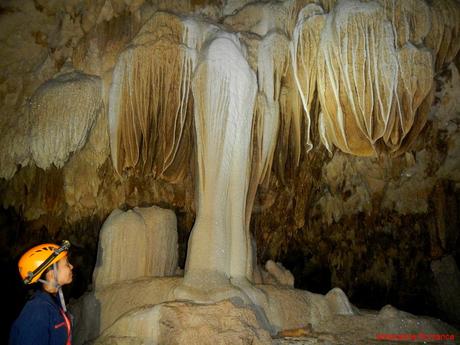
(Cover photo credit: Edgar Alan Zeta-Yap)
For caving guideship services, please get in touch with Joni Abesamis Bonifacio of Trexplore the Adventures using the following details:
- Mailing Address: Abesamis Store, Allen Avenue, Catbalogan City, Samar, Philippines 6700
- Cellphone Number: 0919-2943865/0915-9903553
- Landline: 063-055-2512301
- Email: [email protected] / [email protected]
- Website: Trexplore the Adventures
- Lobo Cave Facebook Page: Lobo Cave
- Trexplore Facebook Page: Trexplore the Adventures
Itineraries, tips, and budget to follow

